‘Normal’ posture is developed during childhood. Young children generally have good postural habits.
A number of factors affect posture - the need to keep the eyes level and relative muscle balance around the pelvis and shoulder girdle areas.
When viewed from the side the ideal posture has the ears directly over the shoulder and hip. A straight line drawn between these three points should pass through the knee and reach the ground just in front of the ankles.


When viewed from the back or front the body should be largely symmetrical but not necessarily perfectly so. The spine viewed from the back is normally straight but will vary slightly over time with activity and dynamic use. The arms should hang equally and freely on either side
The curves of the spine should not be excessive but may become so with poor habits.
Sitting posture is determined by the position of the pelvis, specifically if it is tilted back or forwards. Neutral tilt is considered the best position for for good posture (See below).
There are a number of factors which determine this position including seat height, seat depth, seat angle muscle tightness and weakness etc.
At the other end of the spine the head position, eye level, and the objects being looked at impact on the seated posture.
If the pelvis rolls backwards the spine must become flexed, which is a stressful position for the tissues, and should be avoided for very prolonged periods.

Examples of poor posture while using a portable device are shown here
Mobile digital devices, such as laptops, phones and tablets, are increasingly in regular use and often over prolonged periods of time.
Their use may be a risk to health, and this risk should be minimised if possible. Many of the same principles apply to the use of portable devices as does to using a desktop computer.
All mobile devices are designed to be used in a wide variety of situations and environments. There are a number of things you can do to use them safely and effectively.
There are no universally agreed defined ‘safe’ time limits for using portable computer devices. Where extended use is undertaken, a suitable desk and chair setup should be provided.
- Sustained usage may be continuous use for periods of 30-60 minutes; and
- Extended usage may be continuous use periods of >1 hour
A good alignment of the head, neck and spine during use is key to preventing injury and maintaining good posture, with a particular focus on the alignment of the:
- Back, Head, Neck + Shoulders,
- Arms + Forearms and Wrists + Hands
Use a comfortable position / posture - awkward postures should be avoided. Sustained or Extended use while adopting an awkward postures is highly risky and is not recommended. An awkward posture may include
- Sitting on the floor,
- Sitting cross legged;
- Standing leaning sideways or forwards onto a support (wall / bench)
- Side lying on a floor
- Slouching (back or forwards) whilst seated;
- Resting device on an hand / arm for prolonged periods.
It is generally recommended that rest breaks are taken for at least 5 minutes for every 30 minutes of continuous use
Regular breaks should be combined with some physical stretches and / or exercises. Eye exercises and visual rest will assist in preventing eye strain (e.g. look at an alternative object several metres away for up to 20 seconds).

Maintain a comfortable viewing distance from the screen – approximately 45-70 cm.
Tilt the screen so that it is at a right angle (90’) to the user’s line of sight. Normal line of sight, when the head is upright, is 10’ – 15’ below the horizontal but can go down as far as 30’. Thus the device screen should be held at 105’-100’ to the horizontal but no flatter than 120’ to the horizontal.
Position device so that reflections and glare do not cause a visual disturbance.
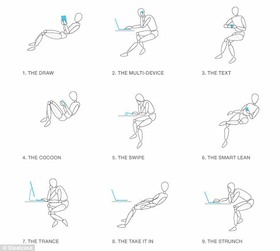
Safe Usage Guidelines
These two documents give some guidance on age appropriate seating and the importance of chair + desk heights that are appropriate for growing children and youths.
Ergonomic Health + Safety Seating for Growing Child
For Children
Work posture may be either static or dynamic, or a mixture of both - one part of the body does the work while other areas hold a static position.
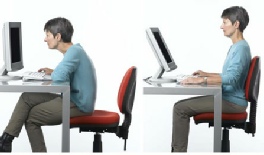
It is best if both the desk and chair are adjustable in height. If so adjust the chair first and then the desk to the appropriate height for the seated worker.
The more common situation is where the desk height is fixed and ergonomic principles are applied to the workstation in order to make it as safe and effective as possible.
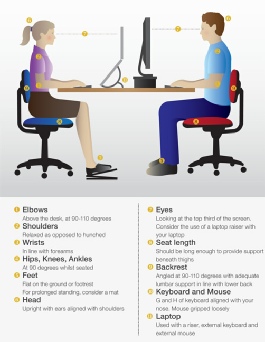
The minimum requirements to maintain good posture are
- Feet flat on floor or supported on a footrest IF the feet are hanging off the floor
- The knees and hips are flexed at approx 90’.
- The legs should not be crossed
- The arms should hang relaxed at the sides.
- The forearms are horizontal just above the level of the desk top, with the elbows bent 90’.
- The wrists are in neutral - neither excessively flexed / extended nor bent sideways.
- The back should be straight and supported by the backrest with the lumber support positioned in the hollow of the lower back.
- A slight forward tilt on the seat may help
- The shoulders should be overhead the hips
- The arm should not be excessively stretched forwards to reach the mouse or the keyboard
- The head should not be forward of the body (protruding chin) or constantly looking down
- The screen should be positioned with the top edge at eye level and approximately at arms length from the body
The following shows some poor posture
Sitting / office Workstations

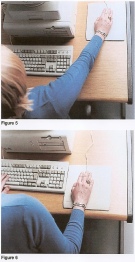
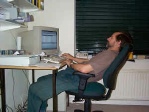
When standing work is it is important to keep the spine straight alignment wherever possible. Where bending is required it should be kept to a minimum and should not be held for long periods.
Key factors to be considered will include what the hands need to do, where the feet need to be placed,, what surface is being stood on and how stable it is, the head position and eye level / sight lines.
The task itself will also determine the correct height at which the workstation is set as precision work requires greater support for the upper limbs - a higher level - while heavy work needs the body weight to be used during the task - needs a lower level. The following give some indication of what is needed.

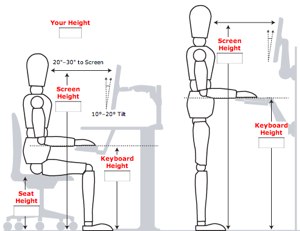
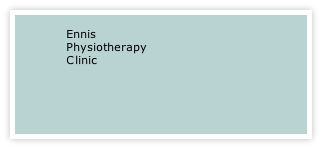




Mon - Fri 9.30am - 8.30pm


3A Barrack Close, Barrack St., Ennis, Co. Clare V95 X437

065 6840757
| Health+Safety Services |
| Sports Clubs+Teams Services |
| Standing Posture |
| Sitting Posture |
| Childhood Posture |
| Using Portable Devices |
| Normal Walking |
| Running |
| Running Drills Videos |
| Muscle Energetics |
| General Fitness |
| Losing Body Weight |
| Gaining Body Weight |
| Weight Loss Programmes |
| Start to Run |
| Start to Swim |
| Start Cycling |
| Start Nordic Waliking |
| Rehab of Tensdons |
| Loading of Tendons |
| Non Specific LBP |
| Posture |
| Intervertebral Disc |
| LBP Treatment |
| Non Specific Neck Pain |
| Neck Care Advice |
| Hamstring Strain |
| Ankle Sprain |
| ACL Injury |
| Joint Replacement |
| Shoulder Dislocation |
| Tennis Elbow |
| Wrist fracture |
| Fractured Knuckle |
| Selecting a Racquet |
| Racquet Grip Size |
| Racuet Sport Injuries |
| Training for Racquet Sports |
| Ski + Board Injuries |
| Injury Videos |
| Injury Prevention |
| Preventing Injury in Musicians |
| Irish Dancing |
| Preventing Dance Injury |